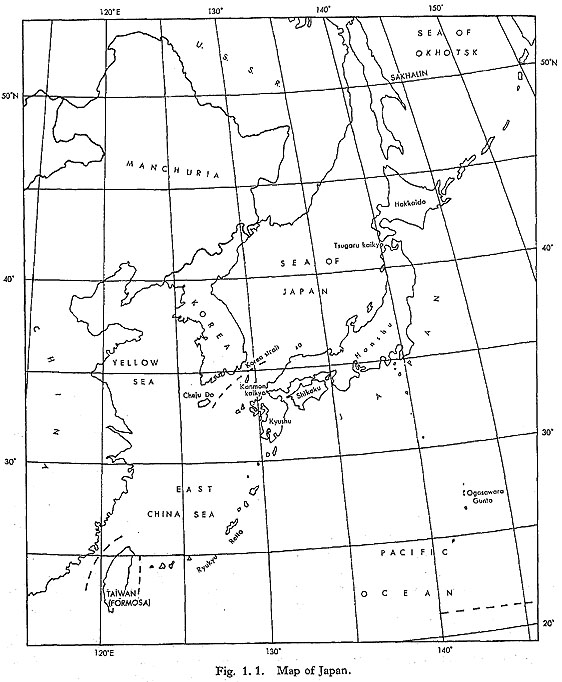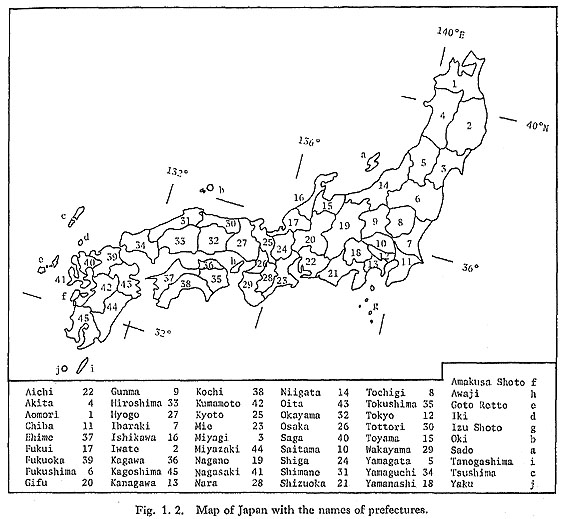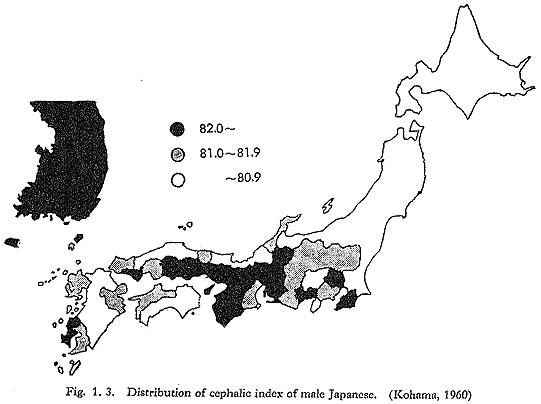CHAPTER 1
Introduction
|
Because Japan is an island nation, anthropologists have long been interested in the questions of when and from where the ancestors of the present-day Japanese came to the Japanese archipelago. If variations in the physical constitution of modern Japanese could be shown to recur in a definite geographic distribution pattern, this might reflect events which took place in prehistoric times, for example the migration of ancestral populations from the Asian Continent. Again, if the physical characteristics of modern Japanese are similar to those of other populations, this might be a reflection of phylogenetic relationships. Analyses of geographic variations in the physical constitution of modern Japanese,1) as well as of the relationship between the physical characteristics of modern Japanese and other Asian populations, are indispensable tools for the clarifcation of these basic problems in anthropology. 1. Historical BackgroundBaelz was the first to make systematic observations on the physical characteristics of the Japanese, as well as the first to collect somatometric data on a considerable number of living subjects (Baelz, 1885). Working in Japan, he posited the existence of two types of Japanese: the fine Choshu type and the sturdy Satsuma type. These types were named after the provinces of Nagato (now part of Yamaguchi Prefecture) and Satsuma (now part of Kagoshima Prefecture), from where he thought that many of the Choshu and Satsuma types had come. Baelz's types, however, were based on observations about social class as well as physical characteristics, and as a result do not necessarily coincide with the types proposed by later investigators on the basis of nation-wide surveys. The first analysis of nation-wide geographic variation in somatometric data was made by Hasebe, using measurements of the stature of conscripts obtained in 1916 (Hasebe, 1917a). He investigated the geographic difference in average stature by prefecture, and found that average stature in adjacent prefectures did not differ drastically, that the pattern of difference in average stature did not coincide with the geographic arrangement of the prefectures, and that there were several centres of gradual increase in average stature. He considered these facts to be evidence for the hypothesis that the Japanese people has arisen through hybridization between several racial groups based in differentareas. Investigating the modern Japanese crania, he also found that there were two types of crania (Hasebe, 1917b). In 1910s, Matsumura measured stature, head length, and head breadth in about 6000 male and about 2000 female students from all over Japan, and correlated the results with geographical origin (Matsumura, 1925, 26). He concluded that the cephalix index showed an. obvious geographic difference, but stature did not. He also pointed to the fact that Japanese resemble other East Asian populations, but did not speculate as to how geographic separation arose. In later years, somatometric data for a large number of measurement items were collected from various areas of Japan, and many of these were compiled and classified by Miyake (Miyake, 1940). Because the data did not cover the whole of Japan, he avoided generalizations on geographic variation. However, he did analyse the typical physical constitution of modern Japanese, and compared the skeletons of modern Japanese with those of the inhabitants of stone age Japan. In this way he arrived at several features of the ancient Japanese: short stature, long and relatively low head, well-developed supraciliary arches and glabella, relatively sunken orbits, hairiness, high frequency of bodyodor, and low frequency of the Mongolian fold. He also stated that these characteristics were common to the inhabitants of geographically isolated regions in which consanguineous marriage had been the rule. In the 1930s and in 1940s, somatomertric data on the inhabitants of Korea were collected by Kohama and others (Arase et al., 1934; and others) and on the peoples of northern Manchuria by Imamura and Shima and others (Imamura and Shima, 1938a, 38b; and others). On the basis of these data, they concluded that the geographic differences within Japanese are comparable in degree with inter-racial difference (Kohama, 1938; Imamura, 1973). This became one of the foundations of the theory which holds that the Japanese people are somatically heterogeneous. During World War II, a National Physical Survey Commission, headed by Seiho Nishi, was established in order to determine the racial characteristics of the somatic and cephalic features of the inhabitants of Japan, and a nation-wide somatometric survey was carried out during the period between 1942 and 1945. However, the data collected by this commission have yet to be fully analysed. After World War II, the National Somatometric Research Group, headed by Tsunekichi Ueda, was established, and a nation-wide somatometric survey was made during the period from 1949 to 1953, on subjects from the general population (NSRG, 1950, 51, 52).Analysing data collected mainly by this commission, Kohama divided the inhabitants of present-day Japan into two types based on the cephalic index: the mesocephalic Tohoku-Uranihon (Tohoku and seaside areas of the Sea of Japan) type, distributed in the Tohoku, northern Kanto, Hokuriku, San'in and northern Kyushu districts; and the brachycephalic Kinai type, distributed along the seashore of the Inland Sea of Japan (Setonaikai), in Kinki, Tokai, Chubu and the southern Kanto districts as well as on the island of Tsushima (Fig. 1. 3). He argued that the Tohoku-Uranihon type resembled dolichocephalic Ainu, and the Kinai type resembled brachycephalic Koreans, and explained the distribution pattern of the cephalic index as follows: originally the Tohoku-Uranihon type was distributed all over Japan. Then came tall, brachycephalic, and high-headed people from Korea; they moved eastward through the coastal areas of the Inland Sea of Japan, came to Kinai and settled there, while part of them proceeded to the east. If the Kinai type represents these migrants, the present Tohoku-Uranihon type represents the hybrid descendants of both the original Tohoku-Uranihon type and the Kinai type. The original Tohoku-Uranihon type, which has remained unchanged, is represented by the present Ainu. This explanation is the so-called "hybrid theory".
There is another explanation for geographic variation in modern Japanese. This is the "transformation theory" proposed by Hasebe, which may be summarized as follows (Hasebe, 1948): from an anthropological point of view, Japanese are quite different from Koreans but similar to the South Chinese. Consequently, it seems probable that the ancestors of modern Japanese migrated from South China before the formation of the Tsugaru and Chosen channels, in the same way as Japanese monkeys and stegodons Late Pleistocene inhabitants of China, such as the upper cave men, show a characteristic variation comparable to inter-racial variation. Therefore, geographic differences in modern Japanese may stem ultimately from the various racial elements which existed in South China around the time of the migration. Human evolution continued even after the appearance of Homo sapiens sapiens and the early inhabitants of Japan may have come to resemble modern Japanese around the Kofun period, or the protohistoric age. Kohama's "hybrid theory" has been criticized for oversimplifying geographic differences, for neglecting the elements which relate Japanese to South Chinese (Yamaguchi, 1977), and for not taking a macroscopic view of the formation of the Mongoloid race (Hanihara, 1980). As for the "transformation theory" of Hasebe, it has been demonstrated that changes in cranial characteristics (Suzuki, 1969) and in stature (Hiramoto, 1972) have been continuous in the districts around Kanto from the Jomon period to the present-day. Investigations of the skeletal remains, however, suggest that some migrants may have arrived in the area around Kanmon channel and northern Kyushu from the Asian Continent towards the end of the Jomon period (Kanaseki, 1976). Recently, Ikeda has analysed the geographic variation in Japanese using the multivariate analysis method (Ikeda, 1978: Ikeda and Tagaya, 1980). Ikeda and Tagaya selected 6 somatometric measurement items (height, biacromial breadth, head length, head breadth, bizygomatic breadth, and face height (spo-gn)2), obtained in 706 locations all over Japan during the ten years following 1950, and analysed them by discriminant function analysis. Their results are: among the populations of the main islands (Honshu, Shikoku and Kyushu), the southern Kyushu population is somewhat unique, and there is a marked difference between the populations in the central region of Honshu (eastern Chugoku, Kinki, Tokai, and southern Kanto) and the populations in the peripheral region (Oh'u and Hokuriku). These results are applicable to both sexes, but inter-population differences are more significant for males than for females. These results are compatible with those of Kohama. 2. Problems in MethodologyThe most important problem in arguing for or against a phylogenetic relationship based on anthropometric data is that morphological similarity, or similarity in metrics, may reflect not only a phylogenetic relationship but also similarity in environment. For example, climate shows significant correlation with skull metrics (Guglielmino-Matessi et al., 1979), weight and weight/body-surface-area (Schreider, 1950; and others), nose shape (Steegmann, 1975; Carey and Steegmann, 1981) and the cephalic index (Beals, 1972). Height, head length and head breadth have all been regarded as racial characteristics, but investigations on Japanese immigrants to the United States and on Nisei revealed that the metrics of the Nisei, who were born and reared in the new environments, were considerably different from those of their parents, who were born and reared in Japan. These measurement items also show remarkable secular change in Japan during the last 100 years (Suzuki, 1963; Yanagisawa and Kondo, 1973; Hoshi, 1977). Consequently, the effects of environmental factors, such as climate and nutrition, as well as the effects of secular change should be taken into account, for they can produce similarity in metric data. This point has not been paid due attention. In addition to the above-mentioned points, the following shortcomings of traditional methods of analysis of geographic difference and the relationship between populations may be mentioned: 1) intra-population variation has been ignored; 2) Japan has been subdivided into areas too small to give a general picture of geographic variation; 3) measurement items have been used without examination of their biological significance, and 4) measurement errors have been made. 3. The Present AnalysisThe purposes of this study are, firstly, to clarify the extent to which somatometric data entitle us to posit geographic variation in modern Japanese, and secondly to investigate how modern Japanese have come to be as they are today by examining geographic variation and the relationship between modern Japanese and other Asian populations. As mentioned above, somatometric data have several shortcomings as indicators of phylogenetic relationships. Compared with other kinds of data, however, they are easy to collect and thus have the advantage of abundance. In this study, the following steps were taken to compensate for the above shortcomings:
|
|
1) Hereafter referred to simply as "geographic variation".[return to the text] 2) See Chapter 2.[return to the text] 3) See Chapter 6.[return to the text] |


